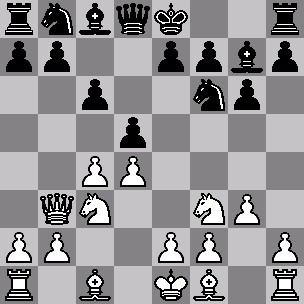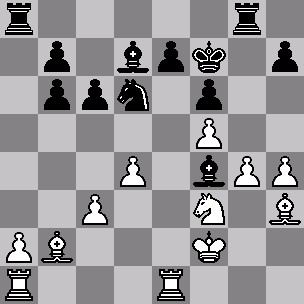14.01.2006
Wijk aan Zee round 1: Aronian-Ivanchuk
Aronian (2752) - Ivanchuk (2729)
Wijk aan Zee Netherlands (1), 14.01.2006
Annotated by Konstantin Sakaev
1.d4 Nf6 2.c4 g6 3.Nf3 Bg7 4.g3 c6 In the first round Vasily Ivanchuk prefers a safer variation. The alternative 4...0-0 leads after d7-d6 to a King's Indian, and after d7-d5 without preliminary c7-c6 sharp lines of the Gruenfeld defense arise.
5.Nc3 d5 6.Qb3
A sneaky line, which is favored by many specialists of the g2-g3 variation. It was used by supergrandmaster Vladimir Kramnik, who tortured Boris Gelfand for more than 60 moves. I would also like to remind that Anatoly Karpov in legendary matches against Garry Kasparov often employed a scheme associated with exchanging on d5.
6...0-0 7.Bg2 Qb6 8.0-0 Rd8 In the aforementioned game Kramnik-Gelfand, Dos Hermanas 1996 there was 8...Bf5 9.Ne5 e6 10.Bf4 Nbd7 11.Qxb6 axb6 12.f3, and Black got problems with the light-squared bishop. Vasily supports the d5-pawn by the rook so far.
9.h3 The move h2-h3 is always useful in this variation: Black's pieces are now deprived of the g4-square, and Bf5 can be met by g4. More popular continuation is 9.c5, which was also played by Levon: 9...Qxb3 10.axb3 Na6 - b3-b4 must not be allowed. 11.Bf4 Nd7 12.Rfd1 e5!? 13.Nxe5 Nxe5 14.Bxe5 Bxe5 15.dxe5. White retains a small advantage, but the game Aronian-Svidler, Beer Sheva 2005 ended in a draw.
9...Be6 Forcing White to make a decision about pawn structure. Also possible was an unassuming 9...Bf5, in order to complete the development.
10.Ng5!? This leads to a lively and interesting game. I would prefer to seqize space by 10.с5, but this is a matter of taste, features of the playing style. After that the game could develop in the following direction: 10...Qxb3 11.axb3 Nbd7 12.b4 a6 with White's minimal advantage. One of White's ideas in the arisen structure is to transfer the knight to a5, where it entangles Black with defending the b7-pawn.
10...Bf5 11.Qxb6 axb6 12.cxd5 Nxd5 Not good is 12...cxd5 13.g4, forcing the Black's knight to return to с8.
13.e4 Nxc3 14.bxc3 Bd7 15.f4! The only disadvantage of White's position is the backward a2-pawn, but it is greatly compensated by the powerful pawn center. Strictly speaking, we are still in the middlegame despite the queens being traded.
15...Na6 16.g4!?
Very creative! White plans to carry out f4-f5, but after possible gxf5 he doesn't want to take on f5 with the e4-pawn. Now Black might bring the bishop back to e8 and try to initiate some play against White's light-squared weaknesses on the queenside. Let's see whose trumps will prevail.
By the way, Anand's 24...Nc7?? looks a capital blunder, the knight can be taken. Still, Black's position was very difficult even without committing such a suicide. I analyzed this line in 2004 and reached the position after 22.h4, assessing it as clearly better for White. Anand's choice of such a difficult line is very surprising.
...I sigh in admiration of Anand's computer analyses depth! After a healthy 3-minute thought the computer just REVERSED the assessment! We were wrong; it is absolutely fantastic!
16...Nc7 17.f5 Nb5 18.Bb2 White covers the a3-square and supports the pawn on d4, but still the bishop's location is far from being attractive. On 18.Bd2 Black could play 18...gxf5 19.gxf5 Ra3 or 19...с5.
18...Bh6 19.h4 f6 Now White encounters a not easy choice between 20.Nf3 and 20.Ne6 with unclear consequences in both cases.
20.Nf3?
Kasmky has a poor position against Topalov. The Bulgarian's advantage looks decisive... Adams has a compensation for a pawn, and it might suffice to equalize... Mamedyarov-Bacrot: Shak rejected the repetition of moves, although he has less time and there is no advantage... Gelfand-Leko is close to equality... Anand took on a3 with the knight. This seems to win as well; the line I had found runs 28...Rxa3 29.Qxf7+ Kh8 30.bxa3 Nxa3+ 31.Kb2 Nc4+ 32.Kc3 Ne5+, Black takes the queen and mates... Van Wely has a clear advantage against Sokolov.
Back to Topalov-Kamsky for a moment: set up the position after 16th move, and play 17.Be5. This could easily force an immediate resignation.
20...gxf5 21.exf5 A correct decision, as after 21.gf5 the move h2-h4 becomes pointless, and Black is better, considering a poor placement of the bishop on b2. Now White has a counterplay associated with the threat of g4-g5 and the pressure on the e-file.
21...Nd6! Weaker is 21...Be3+, after which the bishop becomes vulnerable to the attacks of White's rooks. Ivanchuk's play in this game is very strong.
22.Rfe1 Kf7 23.Bh3 Defending in advance against Rg8 and threatening g4-g5 under favorable circumstances. The latter threat is best parried by 23...Bf4, hinting at the h7-h5 break. Black has slightly better chances.
23...Rg8 This is also possible, Bh6-f4 will probably be played on the next move.
24.Kf2 Bf4
25.Ne5+ Black strongly threatened h7-h5, and Levon seeks salvation in tactics.
25...fxe5 26.dxe5 Ivanchuk now has to choose between two winning continuations: 26...Nxf5 27.gxf5 Bg3+ 28.Kf3 Bxe1 29.e6+ Kf8 30.Rxe1 Be8 winning an exchange, or 26...Nc4 27.e6+ Kf8 28.exd7 Nxb2, winning a piece.
How did it happen that Aronian appeared in a very bad position so quickly? Well, instead of 16.g4!?, 16.Rb1 looked normal, but the text move is not a mistake. The real error has been made on 20th move: 20.Nf3? After 20.Ne6!? the position remained unclear and very complicated.
Topalov duly won his first game. Kamsky simply failed to go out of the opening.
26...Nc4 27.e6+ Kf8 28.exd7 Nxb2 29.Re4 Bd6 30.Ke3 b5 Aronian has just one minute left.
Van Wely-Sokolov: looks like a draw, the players repeated moves already twice... Leko is close to a draw against Gelfand. The Israeli grandmaster pressured his opponent for the whole game, but Peter defended well. The rook ending in Tiviakov-Adams looks drawn to me, a draw is the most likely result.
31.Rb1 Nc4+ 32.Rxc4 bxc4 33.Rxb7 Now 33...Kg7, and White has no time for Bh3-f1-c4-e6, because 34.Bf1 is met by 34...Ra3. If White plays 34.g5, then 34...Rgd8 and the a8-rook begins eating White's queenside pawns.
33...Kg7 34.Bg2 Kf6 35.g5+ Kxf5 36.Bxc6
36...Rab8?!
White had no threats, so 36...Rxa2 or 36...Bc5+ 37.Kf3 Ke5 (the simplest) was more precise. Now Ivanchuk must calculate, although the win is not missed.
37.Kd4 Kg4 38.a4 Kxh4 39.a5 Rxb7 40.Bxb7 Kxg5
41.a6 Bb8 42.Kxc4 Black has many ways of winning this, here is one, maybe not the most precise: 42...h5 43.Kd5 Kf6 44.Kc6 h4 45.c4 h3 46.c5 h2 47.Kb6 Rd8 48.a7 Bxa7+ 49.Kc7 Rxd7+ 50.Kxd7 Bxc5. 42...Kf6 followed by e5 and Ke7 is even simpler.
Still, I am afraid to place a bet on Ivanchuk's win (the coefficient is 1.15 to 1), as Vasily is clearly very nervous: otherwise the move 36...Rab8?! would not come to his mind.
42...Kf6 43.Kb5 e5 44.Kb6 Ke7 So Vasily calmed his nerves and chose the best way of converting an extra rook.
45.Bc8 Rg2. White resigned. 0-1
Aronian played overambitiously today, while Ivanchuk conducted the game perfectly. It is possible that he approached the Wijk aan Zee in excellent form, and then he might challenge the main favorites Topalov and Anand.
Tomorrow we will comment the game Adams-Topalov - see you!






